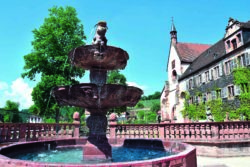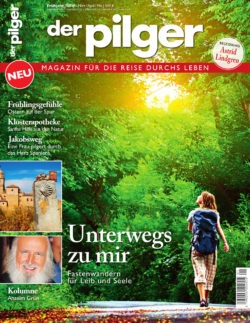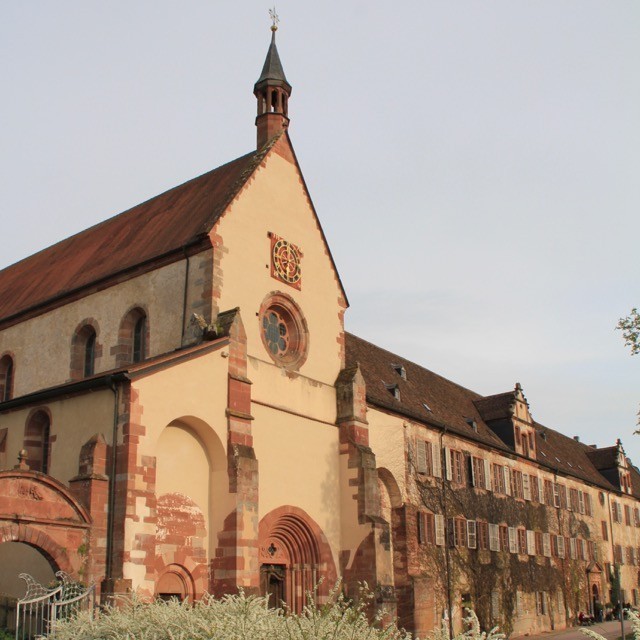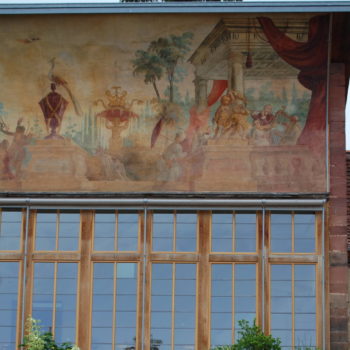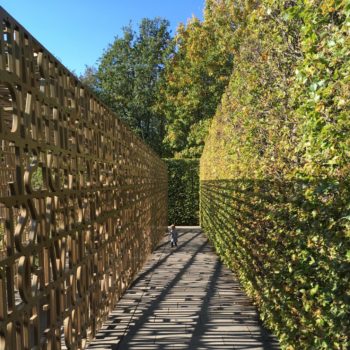Habent sua fata et horti – Gardens, too, have their fate. This thoughtful, somewhat transformed aphorism came to my mind when I visited the abbey garden at Bronnbach Monastery. I had been there before, but when I returned to the lovely Tauber valley, I could admire the garden for the first time in its newly revived and fully restored splendour.
Over the years it was mostly abandoned to its fate but not completely forgotten. The ravages of time had taken their toll on the sculptures, the stone enclosure was staggering. Where beds of flowers and herbs once were nursed, everything was sodded with prosaic grass. No water was burbling in the fountain.
And yet the garden in Bronnbach was long-lived. After all, its current outside appearance is mainly derived from the baroque period. And the baroque style was known for its unique way of depicting eternity in the ephemeral. Baroque architects designed buildings, rooms and gardens in line with the tastes of the time, but in doing so they always pursued to recreate the eternally valid, the eternal ideas and to bring them to the present. Indeed, many baroque works appear to be decrepit and evanescent today, but they are not irretrievably lost.
This also holds true for Bronnbach Garden. The Cistercian monastery it belongs to is located a few kilometres outside Wertheim, not far from Würzburg, and was continuously inhabited by monks from its foundation in 1153 until its dissolution in 1803. As most monasteries, it was significantly redesigned in the baroque period to suit the tastes of the time. The cultivation of herbs, fruits and vegetables was no longer the only purpose of the garden, nor was the garden merely a place for contemplation and recreation in nature, it was now furnished with allegorical sculptures intended to inspire the visitor’s soul and spirit and designed after the vast baroque palace gardens. Their architectural principles were also adopted by the monasteries, which took the form of residences at that time. The sandstone sculptures in Bronnbach, and the baroque garden in general, corresponded with the new function of the monastery buildings, which, after secularization, were used as a palace across the 19th and into the 20th century.
For the past 30 years, however, Bronnbach has been gradually reclaiming its former role as a monastic estate – through a cultural program that focuses on quiet sounds while carefully cherishing the secluded, romantic location of the site. The church is still in operation, and the entire monastery premises continue to present the features of a spiritual place.
 A place that is embedded in and surrounded by gardens. Be it the herb garden and the orangery, both located in front of the monastery, be it the small vineyards or the nature trail where you learn everything about quinces. Everywhere in Bronnbach one encounters cultural landscapes in a miniature format. Last year, a lawn for resting and a grass bench in the style of the medieval friar Albertus Magnus were created, which is a symbolic reminiscence of the fact that gardens were held in high esteem during the High Middle Ages.
A place that is embedded in and surrounded by gardens. Be it the herb garden and the orangery, both located in front of the monastery, be it the small vineyards or the nature trail where you learn everything about quinces. Everywhere in Bronnbach one encounters cultural landscapes in a miniature format. Last year, a lawn for resting and a grass bench in the style of the medieval friar Albertus Magnus were created, which is a symbolic reminiscence of the fact that gardens were held in high esteem during the High Middle Ages.
Three years ago, the restoration of the abbey garden, which stretches the entire length of the west wing, began at Bronnbach Abbey. It was, and still is, the monastery’s show garden. Its outlines are framed by a sumptuous balustrade in red sandstone as befits the local surroundings. Even though this type of sandstone is both hard and weather-resistant, it can also crack and become unstable. And so, the balustrade had to be removed and restored in the workshop. The same fate befell the sculptures, which also vanished from the scene for quite some time. The restorers set up their workshop directly inside the monastery. It was not until then that the various layers of the garden’s historic development could be investigated.
The restorers’ goal was to preserve the history of the garden as much as possible and make it accessible again – including the plants that were found on the estate. A large maple tree standing at the northern entrance could be preserved, as well as the historic box hedges. They simply were coppiced and have now been sprouting at the same place for a hundred years and more. Cuttings were planted in the gaps. The four inner garden sections are adorned with roses, historical perennials and, in spring, with blooming bulbs. Lawns adjoin to the north and south, partially shaded by trees. In reference to our times, a picnic area was created in the southern part of the garden, which is a great place for relaxing in summer.
But let’s move away from the bird’s eye view and walk right through the garden’s eastern gate leaving the monastery complex behind. The first impression is a reflection of the enclosed, peaceful world as conveyed by a garden in its perfect form. And the original meaning of “garden” is enclosure. The red sandstone used for the baroque curved balustrades gives the visitor a feeling of warmth and sedateness and is most impressive in the sunshine.
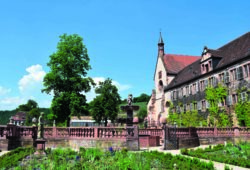 After a few steps, we reach the fountain. A fish made of stone exuberantly jumps out of its upper basin. Its mighty tail fin almost seems to grow into a leaf, as if it would love to become a part of the garden. It is held by two angel figures – called putti – allowing the water to effervesce from its mouth. Lion faces channel it into the bowl below. It is not for nothing that the fountain is the central landmark of the entire garden. Water belongs to a Cistercian monastery like vines to a vineyard (see also page 97). Pisciculture was very common in many monasteries. And, last but not least, the fish is also an ancient symbol of Christ; even before the cross became customary, Christians recognised each other by the sign of the fish.
After a few steps, we reach the fountain. A fish made of stone exuberantly jumps out of its upper basin. Its mighty tail fin almost seems to grow into a leaf, as if it would love to become a part of the garden. It is held by two angel figures – called putti – allowing the water to effervesce from its mouth. Lion faces channel it into the bowl below. It is not for nothing that the fountain is the central landmark of the entire garden. Water belongs to a Cistercian monastery like vines to a vineyard (see also page 97). Pisciculture was very common in many monasteries. And, last but not least, the fish is also an ancient symbol of Christ; even before the cross became customary, Christians recognised each other by the sign of the fish.
Thus, an image that seems worldly at first glance reveals a spiritual dimension, which is typical for the allegorical art of the baroque period. Because after all, allegory means to find the extraordinary in the ordinary.
Two smaller variations of this fountain accomplish the overall effect: the southern one is shaped like a quatrefoil and features a water jet, while the northern one consists of a calm and round water basin. These fountains with their triple approach to water – water in motion, water at peace and water that allows for symbolic interpretation – are one of the most distinctive features of Bronnbach Garden. They allow for a profound meditation on nature and yet provide freshness and coolness as well.
A baroque garden will always refer to something beyond the garden itself and beyond its location. This can also be experienced by visitors to Bronnbach when they marvel at the restored and reinstated sculptures from the 18th century. Revealing the tastes of the time, three motifs are interwoven here with allegories to the continents, the seasons and the virtues. We encounter a Native American with his feathered headdress: America. Africa used to have an elephant head as helmet, but was not returned to the garden. Asia: a female figure wearing a long gown and posing with a camel and a censer. Europe was portrayed in armour and with loot but only fragments of this figure have survived.
The seasons were depicted in a traditional way: Spring comes to us as the goddess Flora, adorned with flowers. Summer is the goddess of fertility: Ceres, holding a sickle and a sheaf. Autumn is represented as Bacchus crowned with vine leaves. And finally, winter unfolds before our eyes and becomes alive as we are discovering the sculpture of an old man in winter clothes next to a fire.
These large statues are complemented by putti of different symbolic functions. But we also find tiny musicians, ornamental artichokes, acanthus baskets and lidded vases in Bronnbach Garden all made of stone and all to add a subtle, playful element to the garden.
Eventually, the garden also draws the mind to the spiritual values, the virtues, over time and space. It is sad to say that these sculptures have suffered most from the ravages of time so that only some of them could be preserved or re-erected.
Most impressive is a bearded man embracing a pillar with his left hand while his right hand is resting on a fire. It is imbued with an aura of steadiness. A female figure in armour seems to be a symbol of strength. Mars enters the stage, war, represented by a man in armour. An old man with a lantern and an owl may symbolise thoughtfulness, or maybe wisdom. Only a fragment remains of generosity which is depicted by an opened bag filled with coins. A female sculpture with a cornucopia alludes to abundance.
 With all these sculptures, visitors to the garden have the opportunity not only to admire artistic sensibility, but also to engage mentally with the world and the great tasks of life – namely to build the soul and character. The flowers, trees and plants as our basis of life are pleasing to the eye and at the same time encourage humility, the awareness of being a part of nature at all times, no matter how lofty thoughts and striving for virtue may be.
With all these sculptures, visitors to the garden have the opportunity not only to admire artistic sensibility, but also to engage mentally with the world and the great tasks of life – namely to build the soul and character. The flowers, trees and plants as our basis of life are pleasing to the eye and at the same time encourage humility, the awareness of being a part of nature at all times, no matter how lofty thoughts and striving for virtue may be.
It is exactly the intimacy and peacefulness of Bronnbach Garden which are so fascinating for visitors. A garden of quiet sounds which – like the entire place and the marvellous monastery in the lovely Tauber valley – has a plenitude of benefits on offer.

